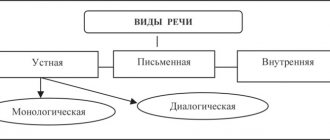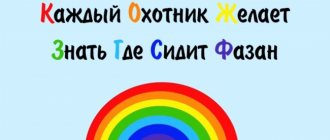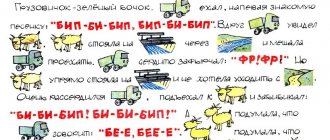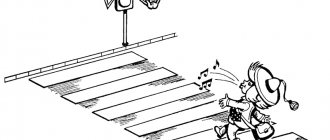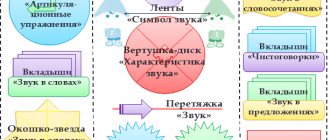Using mnemonic techniques in children's speech development
Batagovskaya Natalya Nikolaevna Malyavina Natalya Nikolaevna educators MBDOU DS No. 27 “Beryozka” Starooskolsky urban district
Today, figurative speech, rich in synonyms, additions and descriptions, in preschool children is a very rare phenomenon. This is monosyllabic speech, consisting only of simple sentences, and the inability to form a common sentence grammatically correctly. At the stage of completing preschool education, the child must have good command of oral speech, use speech to express his thoughts, feelings, desires, and highlight sounds in words.
One of the methods for developing children’s coherent speech is “mnemonics.”
Mnemonics is a system of methods and techniques that ensure successful memorization, preservation and reproduction of information.
Having analyzed all the problems and reasons for the underdevelopment of coherent speech in our group, the goal of the circle work was outlined: to teach children to express their thoughts coherently, consistently, and grammatically correctly, through the use of mnemonics.
A special place in our work with children of senior preschool age is occupied by the use of mnemonic tables.
A mnemonic table is a diagram that contains certain information. The essence of the mnemonic diagram is as follows: for each word or small phrase, a picture (image) is created; Thus, the entire text is sketched out schematically, looking at these diagrams - drawings, the child easily remembers the information.
Advertising message
Symbols of a diverse nature can act as conditional substitutes (elements of the table): geometric figures, symbolic images of objects (symbols, silhouettes, outlines, pictograms), plans and symbols used in them, a contrasting frame - a technique of fragmentary storytelling, and many others.
Work using the method of mnemonic tables consists of several stages:
- Examination of tables, diagrams and analysis of what is depicted.
- Recoding of information, that is, transformation from symbols to images.
- Retelling or storytelling based on symbols (images), that is, the memorization method is being developed.
Children have significant difficulties when composing stories based on the picture. Let us dwell on teaching storytelling based on a separate plot picture “Winter Fun”.
Storytelling consists of 3 stages:
- – highlighting fragments of the picture that are significant for the development of the plot;
- – determination of the relationship between them;
- – combining fragments into a single plot.
We all understand that memorizing poems (pure sayings, tongue twisters, counting rhymes, riddles) brings enormous benefits to a child: their horizons broaden and their memory develops. For better memorization, even a simple schematic diagram of a line or semantic fragment is enough for a child.
1. Pure saying “A fisherman catches fish, all the catch floats into the river”
2.Riddle “One entrance, three exits” – shirt
3. Riddle “The grandfather is sitting in 100 fur coats, whoever undresses him sheds tears” - bow
4.Reader “Glass, lemon, get out, glass of water, get out”
- Poem "White Birch"
Gradually the child begins to show creative independence. Thus, there is a gradual transition from the creativity of the teacher to the joint creativity of the child and the adult. If at the initial stage of work we provide ready-made schemes, then at the next stage we collectively put forward and discuss various versions and select the most successful options.
1. Tongue twisters “6 little mice are rustling in the reeds”, “Sasha knocked over a bump with her hat”, “Our Masha washed her neck in the shower.”2. A retelling of L. Tolstoy’s story “The Bone.”
As a result of using mnemonic tables:
Children's range of knowledge has expanded; there was a desire to retell texts and come up with interesting stories; there was an interest in learning poems and nursery rhymes, tongue twisters, riddles; vocabulary increased; children overcome timidity and shyness.
Thus, the use of mnemonics for preschoolers is currently becoming more and more relevant.
All you need for the job is a piece of paper, markers and a little imagination. And teachers can’t borrow it.
Bibliography:
- Vorobyova V.K. “Methods for the development of coherent speech in children.”
- Glukhov V.P., “Formation of coherent speech in preschool children”
- Voroshnina L.V., “Teaching creative storytelling to preschool children.” Zh-l, Preschool education", 1991, No. 2,3,4.
- Tkachenko T.A. “The use of diagrams in composing descriptive stories.” Journal "Preschool education", 1991, No. 10
MAGAZINE Preschooler.RF
Master class for educators “Development of mnemonic tables for the cognitive development of preschool children.”Compiled by teachers:
- M. I. Ivashchenko
- M. N. Biryukova
Municipal budgetary preschool educational institution “General developmental kindergarten No. 1 “Smile”
Goal: to familiarize teachers with the method of mnemonics as an effective way to develop memory, thinking, and imagination of preschoolers.
Master class plan
- Definition of the concepts “mnemonics” , “mnemonic tables” .
- Mnemonics as an effective way to develop memory, thinking, and imagination of preschoolers.
- Using the mnemonics method when learning poems for children (the “Memorize Poems by Drawing” ).
- Preliminary work with children on mastering the use of mnemonics (coding of individual words, concepts; frequently occurring symbols)
- Stages of work on creating mnemonic tables for poems by children.
- Using mnemonic tables of poems to develop children’s awareness of the world around them, to familiarize children with fiction, and to develop children’s creative abilities.
- Practical task for educators (creating mnemonic tables for the proposed poems).
- Mnemonics (from the Greek mnēmē - memory and téchnē - art, skill) is a set of special techniques and methods that facilitate the memorization of necessary information and increase the volume of memory through the formation of associations (connections). Also, mnemonics implies the replacement of abstract objects and facts with concepts and ideas that have a visual, auditory or kinesthetic representation; linking objects with existing information in various types of memory to simplify memorization.
“mnemonics” also used to designate a visualization (in the form of an image, a set of symbols or objects) of a certain object, subject or phenomenon, which describes it quite fully and facilitates its memorization or identification.
Mnemonics is a system of “internal writing” based on direct recording in the brain of connections between visual images denoting significant elements of memorized information. Mnemonic memorization consists of four stages: encoding into images, memorization (connecting two images), memorizing a sequence, consolidating in memory.
The technical arsenal of modern mnemonics consists of a set of unified memorization techniques that allow you to memorize different information in the same way. The main method of memorization is the method of forming an association (a bunch of images encoding elements of memorized information).
Basic techniques:
- Formation of semantic phrases from the initial letters of memorized information ( “Every Hunter Wants to Know Where the Pheasant Sits” )
- Rhyming ( "Pythagorean pants are equal in all directions" )
- Memorizing long terms or foreign words using consonants
- Finding bright unusual associations (pictures, phrases) that connect with memorized information
- Cicero's method for spatial imagination
- Aivazovsky's method is based on visual memory training
- Methods for memorizing numbers:
- patterns
- familiar numbers
Better to see once than hear a hundred times.
The art of memorization was especially important in pre-literate periods of human history. Thus, priests, shamans, and storytellers had to remember enormous amounts of information. Even after the advent of writing, the art of memorization did not lose its relevance. A very small number of books, the high cost of writing materials, the large mass and volume of the written book - all this encouraged me to memorize the text. It was also affected by the long time spent on the road during travel, when it was impossible to read and write and one had to use what was in memory.
The first texts on mnemonics known to us were created by the ancient Greeks. The art of memorization was also developed by medieval monks, who needed to remember a huge number of liturgical texts. During the Renaissance, when knowledge began to be considered power (Francis Bacon: Knowledge itself is power , the ability to hold knowledge in one’s head was also very, very highly valued. For example, books on mnemonics were written by Giordano Bruno. In his testimony to the Inquisition tribunal, he reports that he published in France a book on memory entitled “On the Shadows of Ideas . Considering the fact that Bruno was invited by the King of France, Henry III, wanting to find out where he got so much knowledge, it should be assumed that Bruno was well versed in the art of memorization.
The use of mnemonics in preschool age occupies a large place. In order to develop certain skills and abilities in children from a very early age, so-called mnemonic tables (diagrams) are introduced into the learning process. In kindergartens, algorithms for the processes of washing, dressing, setting tables, caring for indoor plants, etc. are often used.
Mnemonic tables are a diagram that contains certain information.
The concept of “mnemonic tables” in preschool pedagogy is similar in logic and construction method to the following concepts: sensory-graphic diagrams (V. K. Vorobyova), subject-schematic models (T. A. Tkachenko), square blocks (V. P. Glukhov ), collage (Bolsheva T.V.), scheme for composing a story (Efimenkova L.N.).
2. Mnemonics helps develop:
- visual and auditory memory
- associative thinking
- visual and auditory attention
- imagination
- coherent speech
- lexicon
Let's consider the factors that facilitate the development of children's cognitive abilities:
- One of these factors, according to S. L. Rubinshtein, A. M. Leushina, L. V. Elkonin and others, is visibility. Visualization helps children name objects and phenomena, independently determine their main properties and characteristics, and actions performed with them.
- The creation of a plan of presentation, inference, and statement is considered as a second auxiliary factor, the significance of which was repeatedly pointed out by the famous psychologist L. S. Vygotsky. He noted the importance of sequential placement in the preliminary scheme of all specific elements of the statement and inference (for example, a sequential presentation of the identified features).
- The development of intelligence occurs in the process of the leading activity of preschool age - in play. Considering that at this time children are oversaturated with information, it is necessary that the learning process be interesting, entertaining, and developmental for them.
The combination of these factors is implemented, in particular, when creating mnemonic tables for preschoolers.
A mnemonic table is a kind of VISUAL PLAN of information reproduced in the future.
In preschool age, visual-figurative memory predominates, and memorization is mainly involuntary: children better remember events, objects, facts, and phenomena that are close to their life experience. K. D. Ushinsky wrote about this: “Teach a child some five words unknown to him - he will suffer for a long time and in vain, but connect twenty such words with pictures, and he will learn them on the fly . The use of modeling facilitates and speeds up the process of memorizing and assimilating various information, and forms techniques for working with memory. With this type of activity, not only auditory, but also visual analyzers are turned on. Children easily remember the picture, and then recall the corresponding information.
The use of symbols and patterns that underlie the formation of artificial associations that facilitate memorization and increase memory capacity also contributes to the development of visual-figurative thinking. Reliance on a visual image is very important and mandatory, since if, when reproducing the text, this visual image does not appear in the imagination, then the child does not understand this text. Mnemonics is based on SYMBOLIC ANALOGY - a generalized, abstract, original verbal or graphic image of an object. We constantly encounter symbolic analogies in life. Human speech is written in letters - symbols of sounds; quantity - numbers, number symbols, etc. Symbolic analogy can be VERBAL and GRAPHIC. When working with preschoolers, graphic symbolic analogy is most often used. A graphic analogy is the designation by some symbol of a real image or several images based on their common characteristics. Using a graphic analogy, we teach children the ability to see what is most important.
Preschoolers are very flexible and easy to teach, but sometimes during educational activities it can be difficult to keep their attention - compiling mnemonic tables and their recoding arouses interest in children and helps solve this problem.
Today, figurative speech, rich in synonyms, additions and descriptions, in preschool children is a very rare phenomenon. There are many problems in children's speech.
- Monosyllabic speech consisting only of simple sentences. Inability to construct a common sentence grammatically correctly.
- Poverty of speech. Insufficient vocabulary.
- Use of non-literary words and expressions.
- Poor dialogical speech: the inability to formulate a question competently and clearly, or to construct a short or detailed answer.
- Inability to construct a monologue: for example, a plot or descriptive story on a proposed topic, retelling the text in your own words.
- Lack of logical justification for your statements and conclusions.
- Lack of speech culture skills: inability to use intonation, regulate voice volume and speech rate, etc.
- Poor diction.
Therefore, pedagogical influence on the development of speech in preschoolers is a very difficult matter. It is necessary to teach children to express their thoughts coherently, consistently, and grammatically correctly, and to talk about various events from the surrounding life. And mnemonics can help with this too. The use of mnemonic tables when composing a story helps children to better understand and reproduce the structure of the story, its sequence and lexical and grammatical content, and understand the main semantic links of the plot.
3. Mnemonic tables are especially effective when learning poems. For this there is a technique “Memorizing poems by drawing” . Its essence lies in the fact that for each word or small phrase a picture (image) is created; Thus, the entire poem is sketched schematically. After this, the child reproduces the entire poem from memory, using a graphic image.
3. 1. Like any work, mnemonics is built according to the principle from simple to complex.
Initially, you need to teach children to use pictures as a support for memorizing individual words by correlating each word with a picture that is most suitable in meaning.
To do this, you can use the following tasks:
A word is called, and you need to choose a picture that will help you remember this word. Words: forest, beach, vase, delicious, scary, fun, hot, salty, sour, sea, hello, gold. Then they will show you a picture, and you need to remember the word from it.
Next, you need to teach children to replace key words, concepts with drawings and symbols and sketch them themselves. At the same time, it is important that the graphic image of the object highlights its main features that are characteristic only of it. It is also necessary to limit the time required to depict a word or concept using a drawing, so that children do not get carried away by the details in the image when drawing.
To do this, you can use the task game “Memorize words by drawing” :
A word is called, and you need to draw a picture for this word, which will then help you remember this word. Words: sun, forest, house, bird, sitting, walking, cold, boring, strong, day, looking, wind.
You can also create, together with your children, a card index of symbol cards for frequently encountered words and concepts.
3. 2. After children have mastered the method of symbolic graphic analogy when memorizing individual words and concepts, you can invite them to “sketch” short poems.
At the initial stage, children are offered ready-made mnemonic tables, where each cell corresponds to one word or, later, a whole phrase (line) from a poem. Using reference pictures to memorize poems captivates children and turns the activity into a game. The visual image that the child retains after listening, accompanied by viewing the drawings, allows him to remember the text much faster.
For children of primary and secondary preschool age, it is necessary to give colored mnemonic tables, because children retain individual images in their memory: the Christmas tree is green, the berry is red. Later - complicate it or replace it with another screensaver - depict the character in graphic form. For example: a fox - consists of orange geometric shapes (triangle and circle), a bear - a large brown circle, etc. For older children, it is advisable to draw diagrams in one color so as not to distract attention from the brightness of symbolic images.
The next stage is the independent compilation of a mnemonic table. To do this, children are given clean, empty tables, where the number of cells corresponds to the number of semantic phrases or lines in the poem. Children draw for each phrase or line of the poem a drawing-symbol, drawing-scheme, drawing-association. Gradually, seemingly unrelated pictures are combined into one plot. It is important to note that if the poem contains words that are not clear or familiar to the child, it is necessary to explain their meaning and make supporting drawings. And so, step by step, a mnemonic table is created.
The final stage of working with the mnemonic table is an emotional, expressive reproduction of the text of the poem based on drawings. You can also do vocabulary work on the poem and have a conversation about the meaning of the poem.
3. 3. Mnemonics are multifunctional. Based on it, you can create a variety of educational and didactic games and tasks, adhering to the following requirements:
- the model must display a generalized image of the object;
- reveal what is essential in an object;
- The idea for creating a model should be discussed with children so that it is understandable to them.
During the work on this topic, a series of mnemonic tables for poems was created for the age category of children 4-5 and 6-7 years old on the following lexical topics: “Winter” , “Spring” , “Summer” , “Autumn” . The mnemonic tables were based on the famous poems of S. Marshak, N. Nishcheva, V. Berestov and other children's poets. This series of mnemonic tables-poems can help systematize children’s knowledge about seasonal changes in nature and human life, and also help expand the child’s horizons.
Mnemonic tables-poems are also an effective technique for introducing children to fiction. Working with a literary text becomes a fun, emotional experience for a preschooler, and the content of the text becomes tangible, visible, and imaginable. Based on the mnemonic table, you can build a conversation based on the text; looking at symbolic drawings, trace the sequence of events in a literary work and retell it. All this, in turn, serves to increase children’s interest in children’s literature, and subsequently in reading.
Mnemonic tables-poems can also be used for children to make homemade books. Just cut the already compiled mnemonic table into cells, fasten the sequentially obtained leaves with a stapler and the baby book is ready! Thus, the teacher awakens the child’s interest in creativity, in creating their own creative projects.
4. The essence of the practical task for educators is to independently compile mnemonic tables for the proposed poems. Teachers are given empty mnemonic tables with the text of the poem and colored pencils.
After completing the task, it is discussed according to the following plan:
- What words, concepts, phrases did you find difficult to depict?
- Highlight words in the text of the poem that may be unfamiliar and incomprehensible to children. Try to explain their meaning and choose a symbol or diagram for them.
- What are the differences between mnemonic tables of poems for children 4-5 and 6-7 years old?
- What emotions did you experience while completing the task?
- Your suggestions for the use of mnemonics in the educational activities of preschool teachers, as well as suggestions for improving this methodological development.
References
- Bolsheva T.V. We learn from a fairy tale. Development of thinking in preschoolers using mnemonics. — St. Petersburg, 2005.
- Gromova O. E., Solomatina G. N., Savinova N. P. Poems about the seasons and games. Didactic materials on the development of speech of children 5–6 years old. — Moscow, 2005.
- Guryeva N.A. A year before school. Developing memory: Workbook of exercises on mnemonics. – St. Petersburg, 2000.
- Tkachenko T.A. The use of diagrams in the compilation of descriptive stories / magazine “Preschool Education” No. 10/1990, pp. 16-21.
- Shirokikh T.D. Learning poetry - developing memory / magazine “Child in kindergarten” No. 2 / 2004, pp. 59-62.
- E. A. Yuzbekova Steps of creativity (The place of play in the intellectual development of a child). Methodological recommendations for preschool teachers and parents. – Moscow, LINK-PRESS publishing house, 2006.
| Next > |
Making mnemonic tables
The mnemonic table can be drawn by hand or made up of pictures, like a collage. At the initial stage of learning, it is better to draw small ribbon tables, placing 3-4 pictures in a row. Children are interested in coloring these pictures, and later they can give you their own ideas for drawing.
To create a mnemonic table, you need:
- Break the story into parts, identifying important points (every 2-3 words), draw a sheet of paper into squares;
- Draw a picture for each such moment (describing nouns or adjectives);
- If possible, depict unclear words (verbs or questions) somehow or simply put a “?” sign. The child will need to comment on this.
Various riddles or fairy tales are easier and more fun for young children if they are analyzed in situations and depicted in pictures. Then the child is asked to remember what was described and tell it step by step, looking at the pictures.
At the same time, the following processes occur in the child’s head:
- Looking at pictures and understanding what is shown in them;
- Recoding information from visual to figurative, comparing a picture with a concept;
- Compiling a story from pictures;
- Memorizing a story or poem.
A child in the senior group of kindergarten can independently draw pictures for a mnemonic table after the teacher has broken the story down into situations and told him what to draw. You can draw a mnemonic table for the seasons in a simple and interesting way. Here is a description of winter:
It is better to start working using mnemonic tables with children from the age of 4 years, when they have already developed an initial vocabulary. At this age, you can teach children rules based on tables. These can be algorithms for dressing or washing; there are also mnemonic tables for traffic rules so that the child quickly learns the rules of the road.
Children will enjoy learning fairy tales or poems using the tables:
Our Tanya is crying loudly, She dropped a ball into the river. Hush, Tanya, don't cry! The ball will not drown in the river.
As soon as the child understands the purpose of the mnemonic tables, you can increase the number of pictures, as well as the complexity of the task:
You can make puzzles, riddles or mnemonic tables in mathematics. In the latter case, it is enough to draw a number, and in another square a picture depicting this number. Subsequently, the child retains the corresponding picture in his memory when he sees a number.
If you cannot or do not have time to draw mnemonic tables, you can easily find them on the Internet and download them, then print them and practice with your child. It is better not to show it on a computer; the child will not perceive the screen in the same way as the piece of paper in front of him.

